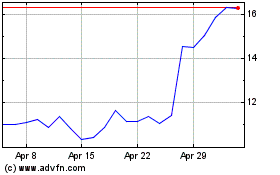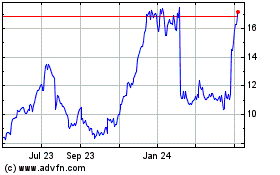By Laura Kusisto
Venice, Calif., is one of the nation's hottest neighborhoods,
brimming with affluent young residents and technology startups like
Snapchat parent Snap Inc. But in one respect, it bears little
resemblance to a boomtown: It hasn't gained a single housing unit
in 15 years.
The ZIP Code encompassing this vibrant Los Angeles precinct is
the toughest place in America to build housing, according to an
analysis of housing data conducted for The Wall Street Journal by
Issi Romem, chief economist at BuildZoom, a website for
contractors.
In all, the area, which encompasses Venice Beach, had about 700
fewer housing units in 2015 than in 2000, as apartment development
stalled and wealthy homeowners gobbled up adjacent properties and
leveled them. Home prices in the ZIP Code have more than tripled in
those 15 years, rising 246% compared with the national average of
52% in the period, according to Mr. Romem's analysis.
Venice Beach is an extreme example of what has been happening in
wealthy urban enclaves across the U.S. that have been resisting new
housing development in recent years.
Apartment developers have stepped up production focused largely
on the inner cores of big U.S. cities, where millennials are
flocking for high-paying jobs and easy commutes, and where
development is often welcomed. Meanwhile, surrounding low-rise
neighborhoods -- many filled with older structures and historical
character -- are keeping developers out.
Residents of these older urban neighborhoods generally have
resisted newcomers, complaining about congestion on roads and
public transportation and seeking to preserve architecture,
sunlight and views.
Yet if U.S. cities want to ease housing-price pressures, Mr.
Romem said, they will have to relax zoning restrictions and allow
tall new buildings across the majority of neighborhoods, not just
in concentrated downtown areas.
"If you want to stunt this housing affordability crisis, you
need to rewrite the rules," Mr. Romem said. "If you don't open the
floodgates, things won't improve."
After Venice Beach, the second most difficult place to build in
the U.S., according to Mr. Romem's analysis, was Prospect-Lefferts
Gardens in Brooklyn, a park-side section of limestone row houses
that is popular with young families priced out of other Brooklyn
neighborhoods. The third-toughest place to build was the Fishtown
section of Philadelphia, a city few think of as hostile to
development.
Fishtown, with a gritty waterfront and working-class roots, has
become an artsy hub as young people move in. But getting new
projects off the ground here is difficult, developers say. Labor
costs are nearly in line with those of New York City, but rents and
condo prices, despite recent gains, are nowhere close.
A proposal to build 23 studio and one-bedroom apartments there,
in a former church, has been in the works for two years facing
opponents who want to preserve an iconic building. One of the
developers, Michael Wachs, managing principal at Linden Lane
Capital Partners, said if his group gives up, another developer
could come in and build townhomes on the site. "We're trying to
save the building," he said, while his opponents "are trying to
bring back a way of life that's not there."
Opponents of the project say that the church is one of the most
beautiful buildings in the neighborhood and a link to its history
and should be preserved in full.
In Venice Beach, the total number of housing units permitted now
under zoning rules is half the number permitted in the late 1950s,
according to an analysis by Dario Alvarez, president of community
planning firm Pacific Urbanism. Developers said even projects that
require only minimal changes to the rules encounter such stiff
community opposition they often lose momentum and die.
Opponents "object all the way through and then they'll take
every appeal that they can," said Frank Murphy, who has been a
developer in the area for 40 years. "Even though they may lose on
appeal, by that time your developers just get dragged out so long
they give up."
Those opposed to new development say it is often aimed at the
very wealthy or very poor and doesn't seem to benefit current
residents of what traditionally have been predominantly
middle-class neighborhoods. New buildings may not fit with the
character or scale of the neighborhood, and too often cities don't
have a plan for the additional strains on transportation and
parking that result, they say.
The Venice Beach population is shrinking even as the local
economy has boomed. The neighborhood had about 27,000 residents in
2015, about 3,800 fewer than in 2000, according to U.S. Census
data. At the same time, the ZIP Code has added 4,000 new jobs,
according to Jed Kolko, chief economist at employment website
Indeed.
A proposal to build what developers say is the neighborhood's
first 100% affordable housing project in 15 years is meeting stiff
opposition. Becky Dennison, executive director of the project,
Venice Community Housing, said land prices in the neighborhood have
risen such that it is virtually impossible to build affordable
housing there.
Her project, a couple of blocks off the beach, represents an
unusual opportunity, she said, because it sits on city-owned land.
It will be aimed at the area's large homeless population, with
subsidies to ensure that tenants would pay no more than 30% of
their incomes on rent.
Ms. Dennison said her group could build 260 units on the site
but has voluntarily scaled it back to 140 apartments after
encountering opposition from local residents. "Not having done [new
affordable development] in so long adds to that fear of the
unknown," she said.
Opponents said they plan to fight the project to the end.
"They're planning a structure of mind-boggling proportions," said
Zelda Lambrecht, a local homeowner and founding member of Venice
Vision, a neighborhood advocacy group. "It's like living next door
to Disneyland."
Other Venice Beach residents lament that rising real-estate
prices and rental rates have made it difficult for residents to
stay. Victoria Taylor, owner of a Moroccan textile and décor shop
in the Mar Vista section who has lived in Venice Beach since 1990,
said she is moving to Austin, Texas. She earns a six-figure income,
she said, but could never afford to buy a house in Venice
Beach.
"It's stupid," Ms. Taylor said. "You can't get a two-bedroom
house here for under $1 million. It's just not worth it for me when
I can get something bigger for less somewhere else."
--Covey Son contributed to this article.
Write to Laura Kusisto at laura.kusisto@wsj.com
(END) Dow Jones Newswires
July 16, 2017 20:09 ET (00:09 GMT)
Copyright (c) 2017 Dow Jones & Company, Inc.
Snap (NYSE:SNAP)
Historical Stock Chart
From Mar 2024 to Apr 2024

Snap (NYSE:SNAP)
Historical Stock Chart
From Apr 2023 to Apr 2024
